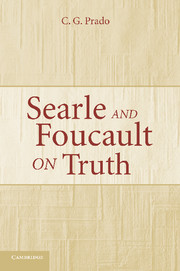4 - Truth, Reality, and Confirmation
Published online by Cambridge University Press: 03 December 2009
Summary
Truth and the World
The foregoing chapters on Searle and Foucault raise many questions, and chief among them is one about what epistemic role Searle and Foucault respectively attribute to extralinguistic reality. For Searle, truth is inextricably related to how things are in the world in that beliefs and sentences are true when they accurately depict how things are, when they square with “the facts.” For Foucault, extralinguistic reality is tacitly acknowledged and put aside in considering truth, because truth is wholly linguistic; truth is discursive currency, and true sentences neither depict nor are made true by states of affairs in the world.
Searle's problem with extralinguistic reality is that the epistemic role it supposedly plays in making beliefs and sentences true eludes satisfactory theoretical articulation. This difficulty is perhaps most evident in Searle's frequent reliance on very simple examples to explain how true beliefs and sentences square with states of affairs. By using simple examples, like the one I consider below about believing one's keys are on a table, Searle in effect precludes the necessity to consider interpretative, identificatory, and descriptive subtleties. In simple examples, the claimed relation of truth to the disposition of the world appears self-evident and difficult to challenge. It is hard to explore issues of interpretation, identification, and description if one is limited to simple examples and has to resort to artificial devices, such as raising issues about what is meant by “keys” or “table.
- Type
- Chapter
- Information
- Searle and Foucault on Truth , pp. 104 - 135Publisher: Cambridge University PressPrint publication year: 2005



